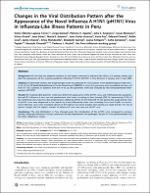Changes in the viral distribution pattern after the appearance of the novel influenza A H1N1 (pH1N1) virus in influenza-like illness patients in Peru
Related Resource(s)
https://journals.plos.org/plosone/article?id=10.1371/journal.pone.0011719Date
2010Author(s)
Laguna-Torres, Victor Alberto
Gómez, Jorge
Aguilar, Patricia V.
Ampuero, Julia S.
Munayco, Cesar
Ocaña, Víctor
Pérez, Juan
Gamero, María E.
Arrasco, Juan Carlos
Paz, Irmia
Chávez, Edward
Cruz, Rollin
Chavez, Jaime
Mendocilla, Silvia
Gomez, Elizabeth
Antigoni, Juana
Gonzalez, Sofía
Tejada, Cesar
Chowell, Gerardo
Kochel, Tadeusz J.
Metadata
Show full item recordAbstract
Se describe la variación temporal en agentes virales en pacientes con enfermedades similares a la influenza antes y después de la aparición de la pandemia de influenza A (H1N1) (Ph1h1) en Perú, entre el 04 de enero y el 13 de julio de 2009. En los centros de salud, se obtuvo un hisopo orofaríngeo para el aislamiento viral. Desde la semana epidemiológica 1 a 18, en el Centro de Investigación Médica Naval de los Estados Unidos destacado en Lima. Las muestras se inocularon en cuatro líneas de células para el aislamiento del virus. Además, desde la semana 19 hasta la 28, las muestras fueron analizadas mediante reacción en cadena de polimerasa en tiempo real. La distribución viral en Perú había cambiado a la introducción del virus pH1N1 en comparación a los meses previos. El virus pH1N1 predomina sobre otros virus de influenza A. We describe the temporal variation in viral agents detected in influenza like illness (ILI) patients before and
after the appearance of the ongoing pandemic influenza A (H1N1) (pH1N1) in Peru between 4-January and 13-July 2009.
Methods: At the health centers, one oropharyngeal swab was obtained for viral isolation. From epidemiological week (EW) 1
to 18, at the US Naval Medical Research Center Detachment (NMRCD) in Lima, the specimens were inoculated into four cell
lines for virus isolation. In addition, from EW 19 to 28, the specimens were also analyzed by real time-polymerase-chainreaction (rRT-PCR).
Results: We enrolled 2,872 patients: 1,422 cases before the appearance of the pH1N1 virus, and 1,450 during the pandemic.
Non-pH1N1 influenza A virus was the predominant viral strain circulating in Peru through (EW) 18, representing 57.8% of
the confirmed cases; however, this predominance shifted to pH1N1 (51.5%) from EW 19–28. During this study period, most
of pH1N1 cases were diagnosed in the capital city (Lima) followed by other cities including Cusco and Trujillo. In contrast,
novel influenza cases were essentially absent in the tropical rain forest (jungle) cities during our study period. The city of
Iquitos (Jungle) had the highest number of influenza B cases and only one pH1N1 case.
Conclusions: The viral distribution in Peru changed upon the introduction of the pH1N1 virus compared to previous
months. Although influenza A viruses continue to be the predominant viral pathogen, the pH1N1 virus predominated over
the other influenza A viruses.
Collections
- Artículos científicos [890]






